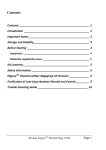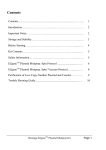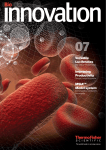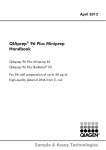Download Manual - Omega Bio-Tek
Transcript
Mag-Bind® Plasmid Maxi Kit Table of Contents Introduction....................................................................................2 Yield and Quality of DNA...........................................................3 Kit Contents.....................................................................................4 Preparing Reagents / Storage and Stability.........................5 Bacterial Culture Recommendations.....................................6 Mag-Bind® Plasmid Maxi Protocol.........................................8 Modified Protocols.....................................................................11 Troubleshooting Guide.............................................................13 Ordering.........................................................................................15 Manual Revision: June 2012 Innovations in nucleic acid isolation 1 Introduction The Mag-Bind® Plasmid Maxi Kits combine the power of Mag-Bind® technology with the time-tested consistency of alkaline-SDS lysis of bacterial cells to deliver high-quality DNA. Mag-Bind® Particles CND facilitate the binding, washing and elution steps thus enabling multiple samples to be simultaneously processed. Mag-Bind® Particles CND can be used on automated liquid handlers such as Beckman Coulter’s Biomek FX and Tecan Freedom Evo. This system also include a special filter cartridge, which replaces the centrifugation step following alkaline lysis. Plasmid DNA purified by this system is suitable for automated fluorescent DNA sequencing, restriction endonuclease digestion, transfection of mammalian cells, and other manipulations. Up to 600-1200 µg high copy number plasmid or 50-300 µg of low copy number plasmid can be purified from 50-200 mL overnight culture using the Mag-Bind® Plasmid Maxi Kit. Yields vary according to plasmid copy number, E.coli strain, and the growth conditions. 2 Yield and Quality of DNA Determine the absorbance of an appropriate dilution (20 to 50 fold) of the sample at 260 nm and then at 280 nm. The DNA concentration is calculated as follows: DNA concentration = Absorbance 260 × 50 × (Dilution Factor) µg/mL A value greater than 1.8 indicates greater than 90% nucleic acid. Alternatively, quantity (as well as quality) can sometimes best be determined by agarose gel/ethidium bromide electrophoresis by comparison to DNA samples of known concentrations. Typically, the majority of the DNA eluted is in monomeric supercoil form, though concatamers may also be present. Plasmid Copy-Number and Expected Yield The yield and quality of plasmid DNA obtained depends on a number of factors including plasmid copy number, size of insert, host strain, culture volume, culture medium and binding capacity of the kits. Of these factors, the vector copy number, culture volume and kit binding capacity are most important. Plasmid copy-number ranges from one copy to several hundred copies per cell as dictated by their origin of replication. But very large plasmids often display a very low copy number per cell. The expected yield of 50 mL overnight cultures (LB medium) with the Mag-Bind® Plasmis Maxi Kit are indicated in the following table. Plasmid Replicon Copy Number Expected Yield pMBI 500-700 150-250 µg pBluescript® vectors ColE14 300-500 100-180 µg pGEM® vectors pMB1 300-400 100-200 µg pBR322 and its derivatives pMB1 15-20 10-20 µg ColE14 ColE14 15-20 10-20 µg PACYC and its derivatives p15A 37540 5-10 µg pSC101 and its derivatives pSC101 ~5 5 µg pMB1 300-700 100-200 µg pUC vectors pGEM 3 Kit Contents Mag-Bind® Plasmid Maxi Kit M1257-00 M1257-01 M1257-02 Preparations 2 5 20 Lysate Clearance Syringe 2 5 20 Mag-Bind® Particles CND 350 µL 850 µL 3.3 mL Solution I 30 mL 60 mL 225 mL Solution II 30 mL 60 mL 225 mL PFC Binding Buffer 20 mL 50 mL 200 mL Neutralization Buffer 30 mL 60 mL 225 mL RNase A 120 µL 300 µL 1.2 mL SPM Wash Buffer 36 mL 90 mL 2 x 165 mL Elution Buffer 10 mL 40 mL 90 mL User Manual P P P Storage and Stability All of the Mag Bind® Plasmid Maxi Kit components are guaranteed for at least 12 months from the date of purchase when stored as follows: Solution I (once RNase A is added) and Mag-Bind® Particles CND at 2-8˚C. All other materials at 22-25˚C. Store Solution II tightly capped when not in use. Check Solution II Buffer for precipitation before use. Redissolve any precipitation by warming to 37˚C. 4 Preparing Reagents • Add vial of RNase A to the bottle of Solution I provided and store at 2-8˚C. • Dilute SPM Wash Buffer with 100% ethanol as follows and store at room temperature. Kit Ethanol to be Added M1257-00 84 mL M1257-01 210 mL M1257-02 385 mL per bottle 5 Bacterial Culture Recommendations Bacterial Strain Selection It is strongly recommended that an end A negative strain of E. coli be used for routine plasmid isolation. Examples of such strains include DH5α™ , DH1, and C600. These host strains yield high quality DNA with the Mag Bind® Plasmid Maxi Kit protocols. XL1Blue, although a slower growing strain, is also recommended due to its yield of highquality DNA. Host strains derivatives from HB101 such as TG1 and the JM100 series release large amounts of carbohydrates during lysis which may inhibit enzyme activities when not completely removed. Some strains may also lower DNA quality due to having high levels of endonuclease activity and therefore are not recommended (i.e. JM101, JM110, HB101). One may reduce the amount of culture volume or double the volumes of Solution I, II, and Neutralization, if problems are encountered with strains such as TG1 and Top10F. Inoculation Bacterial cultures for plasmid preparations should always be grown from a single colony picked from a freshly streaked plate. Subculturing directly from glycerol stock or liquid cultures may lead to uneven yields or plasmid loss. Optimal results are obtained by using one single isolated colony from a freshly transformed or freshly streaked plate to inoculate an appropriate volume of starter culture containing the appropriate antibiotic. It should then be incubated for 12-16 hours at 37°C with vigorous shaking (~300rpm; shaking incubator). NOTE: Aeration is very important. The culture volume should not exceed 1/4 the volume of the container. Culture Media The E.Z.N.A.® Plasmid Kits are specially designed for use with cultures grown in Luria Bertani (LB) medium. Richer broths such as TB(Terrific Broth) or 2 x YT lead to high cell densities that can overload the purification system, and therefore are not recommended. If rich media has to be used, growth times have to be optimized, and the recommended culture volumes must be reduced. NOTE: As culture ages DNA yield may begin to decrease due to cell death and lysis within the culture. 6 Bacterial Culture Recommendations Culture Volume and Cell Density Do Not Exceed Maximum Recommended Culture Volumes For optimal plasmid yields, the starting culture volume should be based on culture cell density. A bacterial density between 2.0 and 3.0 at OD600 is recommended. When using nutrient-rich media, care should be taken to ensure that the cell density does not exceed an OD600 of 3.0. Using a high-density culture outside of the recommended OD range may overload the purification system. 7 Mag-Bind® Plasmid Maxi Protocol Mag-Bind® Plasmid Maxi Kit Protocol Materials and Equipment to be Supplied by User: • • • • • • 100% ethanol (Do not use denatured alcohol) Nuclease-free 50 mL centrifuge tubes Nuclease-free 2 mL microcentrifuge tubes Magnetic stand capable of using 50 mL tubes Ice bucket Incubator capable of 37°C Before Starting: • • • • 1. Pre-chill Neutralization Buffer on ice Preheat Elution Buffer to 70°C if plasmid DNA is >10kb Prepare SPM Wash Buffer and Solution I according to the “Preparing Reagents” section on Page 5 Preheat an incubator to 37°C Harvest cells: Pellet 50-200 mL overnight culture by centrifugation. Optimal volume to use depends on the culture density and plasmid copy number (see instruction in the notes below). Transfer appropriate volume of culture to a centrifuge tube and centrifuge at 4,000 x g for 10 minutes. Note: The optimal cell mass (OD600 x mL culture) is around 300-400. For example, if the OD600 of a culture is 4.0, the optimal culture volume should be 75-100 mL. If excess culture cell mass is used, alkaline lysis will be inefficient. Furthermore, the excessive viscosity of the lysate will require vigorous mixing which may result in shearing of genomic DNA and contamination of the plasmid DNA. For low copy number plasmids, see the instructions for “Low Copy-Number Plasmids” on Page 12. 2. Decant or aspirate medium. To ensure that all traces of the medium are removed, use a clean paper towel to blot excess liquid from the wall of the vessel. 3. Add 10 mL Solution I/RNase A to the bacterial pellet. Resuspend cells completely by vortexing or pipetting up and down. Note: Complete resuspension of the cell pellet is vital for obtaining good yields. 8 Mag-Bind® Plasmid Maxi Protocol 4. Add 10 mL Solution II. Mix gently and thoroughly by inverting and rotating the tube 10 times to obtain a cleared lysate. This may require a 2 minute incubation at room temperature with occasional mixing. Note: Avoid vigorous mixing as this will shear chromosomal DNA and lower plasmid purity. Store Solution II tightly capped when not in use. 5. Add 10 mL ice-cold Neutralization Buffer. Mix gently and thoroughly by inverting and rotating the tube 10 times until flocculent white precipitates form. This may require a 2 minute incubation at room temperature with occasional mixing. Note: The solution must be mixed thoroughly. This is vital to obtaining good yields. If the mixture still appears viscous, brownish and conglobated, more mixing is required to completely neutralize the solution. 6. Prepare a Lysate Clearance Syringe by removing the plunger and place the barrel in a tube rack to keep the syringe upright. 7. Immediately pour the lysate from Step 5 into the barrel of the Lysate Clearance Syringe. Allow the cell lysate to sit for 2 minutes. White precipitates should float to the top. 8. Hold the Lysate Clearance Syringe barrel over a new 50 mL centrifuge tube. Remove the end cap from the syringe tip. Gently insert the plunger into the barrel to expel the cleared lysate into the 50 mL centrifuge tube. Note: Some of the lysate may remain in the flocculent precipitate. DO NOT force this residual lysate through the filter. 9. Add 150 μL Mag-Bind® Particles CND and 9 mL PFC Binding Buffer. Mix well by inverting the tube a few times. Important: The Mag-Bind® Particles CND will settle and bead together at the bottom of their container after several hours. Please check container before use. If beading has occurred, gently shake or vortex container until particles have been resuspended in solution. 9 Mag-Bind® Plasmid Maxi Protocol 10. Let sit at room temperature for 10 minutes with gently shaking or inverting. Note: For low copy number plasmid insolation a 25 minute or overnight incubation can increase yields at room temperature. 11. Place the tube on the magnet separation device and remove the supernatant after Mag-Bind® Particles CND have completely migrated to the walls of the tube. 12. Remove the tube from the magnet separation device. 13. Add 25 mL SPM Wash Buffer. Vortex or pipet up and down to resuspend the MagBind® Particles CND. 14. Place the tube on the magnet separation device and remove the supernatant after Mag-Bind® Particles CND have completely migrated to the walls of the tube. 15. Repeat Steps 13-14 for a second SPM Wash Buffer wash step. 16. Air dry the Mag-Bind® Particles CND pellet for 10 minutes at room temperature. If necessary, remove any liquid drop from the tube with a pipettor. Note: After 1 minute check the tube and remove any residual ethanol. 17. Add 1-2 mL Elution Buffer or TE Buffer. Vortex or pipet up and down to resuspend the Mag-Bind® Particles CND. 18. Incubate at 37oC for 10 minutes. 19. Place the tube on the magnet separation device. Transfer the cleared supernatant containing the DNA to a new 2 mL microcentrifuge tube. 20. Store DNA at -20°C. 10 DNA Precipitation The concentration of the eluted plasmid varies with copy number, host strain and growing conditions. In some cases, residual ethanol may also be present in the eluted plasmid DNA. To adjust the DNA concentration following plasmid DNA elution or for the removal of ethanol residue, one can perform the following isopropanol precipitation. 1. Carefully transfer the eluted plasmid to a clean tube suitable for precipitation. Add 1/10 volume of 3M NaAC (pH 5.2) and 0.7 volumes isopropanol (room temperature). Vortex to mix and centrifuge at >15,000 x g for 20 minutes at 4ºC. Carefully decant the supernatant. 2. Wash DNA pellet once with 1-2 mL 70% ethanol and centrifuge at >15,000 x g for 10 minutes at 4ºC. Carefully decant the supernatant without disturbing the pellet and air dry the pellet for 10 minutes. 3. Resuspend DNA pellet in 200-500 µL Elution Buffer depending on desired concentration of final product. 11 Low Copy-Number Plasmid/Cosmid DNA Purification Low copy number plasmids generally give 0.1-1 µg DNA per mL overnight culture. For the isolation of plasmid DNA from low copy-number plasmids (0.1-1 µg/mL culture) or low midi copy-number plasmid (1-2 µg/mL culture) bacteria, use the following modified protocol. 1. Starting bacterial volume: Double the volume of starting culture from that of high copy number plasmids. Use up to 200-400 mL bacterial culture for Maxi Preps. Pellet the bacterial cells by centrifugation. Note: Additional buffers can be purchased separately. See Page 15 for purchasing information on additional buffers. 2. Perform alkaline lysis steps by using double volumes of Solution I, Solution II, Neutralization Buffer. Additional buffer for Solution I, Solution II, Neutralization. 3. Continue with each step of the standard protocol by following the wash, drying, and elution steps. There is no need to increase the volumes of SPM Wash Buffer or Elution Buffer. 12 Troubleshooting Guide Please use this guide to troubleshoot any problems that may arise. For further assistance, please contact the technical support staff , toll free, at (800-832-8896). Low DNA Yields Poor cell lysis Reduce the initial volume of culture or increase the lysis time while monitoring the lysis visually. Cells may not have been dispersed adequately prior to the addition of Solution II. Make sure to vortex cell suspension to completely disperse. Solution II if not tightly closed, may need to be replaced. Prepare as follows: 0.2 N NaOH, 1% SDS. Bacterial Clone is overgrown or not fresh Do not incubate cultures for more than 16 hr at 37ºC. Storage of cultures for extended periods prior to plasmid isolation is detrimental. Low elution efficiency If using Endotoxin-free water for elution, adjust the pH of water must be pH 8.0 Low copy-number plasmid used Such plasmids may yield as little as 0.1μg of DNA from a 1 mL overnight culture. Double culture volume and follow suggested modifications with low copy number plasmid protocol. Alkaline lysis is prolonged Reduce the lysis time (Solution II) to 3 minutes or until the suspended cells form a clear viscous solution Too many or too few cells were used Confirm the cell density by measuring OD . To calculate the volume of culture to use, take the desired cell mass and divide by the absorbance of the overnight culture at 600 nm. No DNA Eluted DNA Wash Buffer not diluted with ethanol Prepare SPM Concentrate according to instructions on page 6. High molecular weight DNA contamination of product. Over mixing of cell Do not vortex or mix aggressively after adding Solution lysate upon addition of II. Solution II Culture overgrown Overgrown culture contain lysed cells and degraded DNA. Do not grow cell longer than 16 hours 13 Troubleshooting Guide Plasmid DNA floats out of well while loading agarose gel Ethanol has not completely been removed from Magnetic Beads following wash steps. Dry for 5 minutes at 37oC to completely remove Absorbance of purified DNA does not accurately reflect quality of the plasmid (A260/A280 ratio is too high or too low). SPM Buffer is diluted with ethanol containing impurities. Check the absorbance of the ethanol between 250nm and 300nm. Do not use ethanol with high absorbance. Traces of impurities may remain on the binding column after washing and contribute to the absorbance in the final product. Plasmid DNA is contaminated with RNA; RNase A treatment is insufficient. Confirm that the RNase A Solution was added to Solution I prior to first use. The RNase A Solution may degrade due to high temperatures (>65EC) or prolonged storage (> 6 months at room temperature) Purification is incomplete due to column overloading. Reduce the initial volume of culture. Plasmid DNA is contaminated with chromosomal DNA Do not use cultures that have grown for more than 24 hours or are in the cell death phase. Do not vortex or vigorously shake the cells during the lysis reaction or Neutralization procedure. 14 Ordering Information The following components are available for purchase separately. (Call Toll Free at 1-800-832-8896) Product Part Number Solution I (250 mL) PS001 Solution II (250 mL) PS002 Neutralization Buffer (250 mL) PS004 Elution Buffer (100 mL) PDR048 RNase A (400 µL) AC117 HiBind®, E.Z.N.A.®, and MicroElute® are registered trademarks of Omega Bio-tek, Inc. Qiagen®, QIAvac® and Vacman® are all trademarks of their respective companies. PCR is a patented process of Hoffman-La Roche. Use of the PCR process requires a license. 15 Notes: 16





































